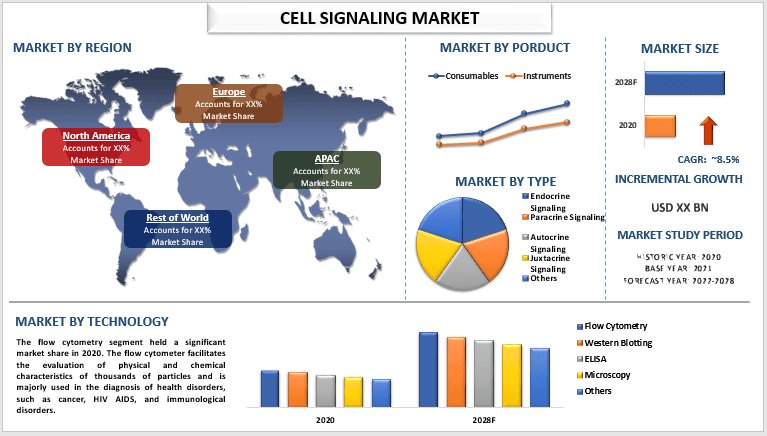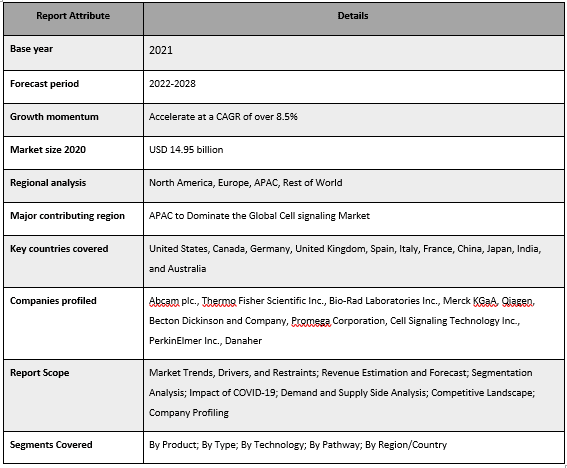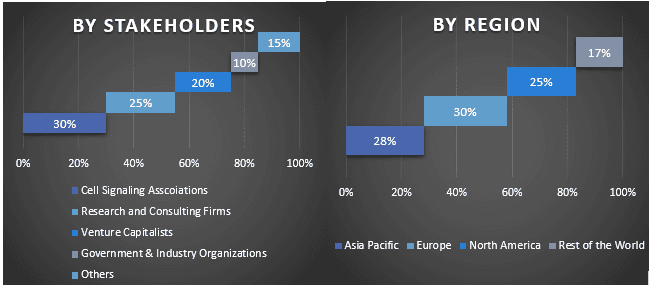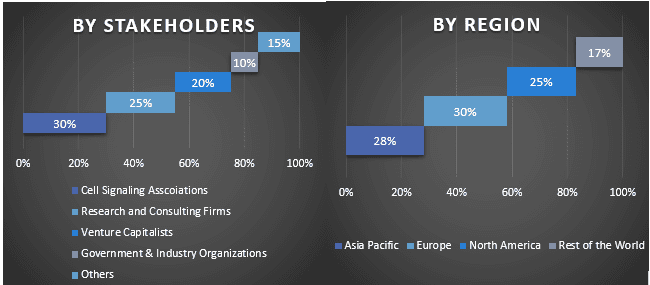Emphasis on Product (Consumables and Instruments); Type (Endocrine Signaling, Paracrine Signaling, Autocrine Signaling, Juxtacrine Signaling, and Others); Technology (Flow Cytometry, Western Blotting, ELISA, Microscopy, and Others); Pathway (AKT Signaling Pathway, AMPK Signaling Pathway, ErbB/HER Signaling Pathway, and Others); and Region/Country

Global Cell Signaling Market is expected to grow at a significant rate of around 8.5% during the forecast period 2022-2028. Cell signaling is the transfer of information from one cell to another. The building blocks of life are cells. A cell needs to communicate well with its neighbors in order to survive. Cells in multicellular organisms send and receive signals from their surroundings in order to communicate and coordinate with other cells, tissues, and organs. The signaling molecule binds to the cell surface receptors, further generating a physiological reaction. To identify patterns of drug resistance in malignant cells, cell signaling is utilized to analyze the signaling pathways of cells in drug discovery and therapeutic development. Additionally, it identifies how crucial signaling pathways are altered by medication therapies. Thus, the increase in the number of patients having chronic diseases leading to a rise in the number of drug discoveries and therapeutic development are also some of the factors contributing to the growth of the cell signaling market globally. For instance, on March 25, 2021, Thermo Fisher Scientific announced the completion of the U.S. Food and Drug Administration (FDA) listing for the Applied BioSystems Quant Studio 5 Dx Real-Time PCR System. The innovative product enables clinical laboratories and assay developers to meet testing demands and enhance molecular diagnostics workflows.
Abcam plc., Thermo Fisher Scientific Inc., Bio-Rad Laboratories Inc., Merck KGaA, QIAGEN, BD, Promega Corporation, Cell Signaling Technology Inc., PerkinElmer Inc., Danaher are some of the key players in the market. Several M&As along with partnerships have been undertaken by these players to facilitate customers with hi-tech and innovative products/technologies.
Insights Presented in the Report
“Amongst technology, ELISA is expected to grow with a significant CAGR during the forecast period”
Based on technology, the market is categorized into flow cytometry, western blotting, ELISA, microscopy, and others. Among these, ELISA is expected to grow with a significant CAGR during the forecast period. The design and development of an ELISA assay depend on various components, including capture antibodies, detection of cell signaling pathways, and research & discovery phases faster.
“Amongst pathways, the AMPK signaling pathway held a significant market share in 2020”
On the basis of pathways, the cell signaling market has been classified into AKT signaling pathway, AMPK signaling pathway, AMPK signaling pathway, and others. The AMPK signaling pathway held a significant market share in 2020. This is mainly due to the rising prevalence of cancer and tumor. AMPK pathway demonstrates both oncogene and tumor suppressor effects depending on the tissue-specific tumor microenvironment. Hyperactive According to the article published in BioMed Central Ltd (BMC), on 17 August 2020, MAPK signaling exists in over 85% of cancers, which is caused directly by genetic alterations of its upstream activators or components.
Cell Signaling Market Report Coverage

“North America held a significant share in the market.”
In 2020, North America held a significant share of the global cell signaling market. This is mainly attributed to the increasing demand of personalized treatment such as cell therapy, gene therapy, etc. for the management of chronic disorders. Moreover, the increasing investments in biopharmaceutical companies and the presence of global players in North America, also act as major factors that drive the growth of the industry. In addition, a wide variety of products are available in the North America market and many novel instruments also got approval in North America during the last few years. Increasing collaborations, partnerships, and acquisitions are also expected to drive the market in near future. For instance, in July 2020, Sartorius AG, a leading provider of contract testing services to the biotechnology and biopharmaceutical industries, bought a majority share in CellGenix.
Reasons to buy this report:
Customization Options:
The global cell signaling market can further be customized as per the requirement or any other market segment. Besides this, UMI understands that you may have your own business needs, hence feel free to connect with us to get a report that completely suits your requirements.
1. Market Introduction
2. Research Methodology Or Assumption
3. Market Synopsis
4. Executive Summary
5. Impact Of Covid-19 On The Cell Signaling Market
6. Cell Signaling Market Revenue (usd Bn), 2020-2028f
7. Market Insights By Product
8. Market Insights By Type
9. Market Insights By Technology
10. Market Insights By Pathway
11. Market Insights By Region
12. Cell Signaling Market Dynamics
13. Cell Signaling Market Opportunities
14. Cell Signaling Market Trends
15. Demand And Supply-side Analysis
16. Value Chain Analysis
17. Pricing Analysis
18. Strategic Insights
19. Competitive Scenario
20. Company Profiled
21. Disclaimer
Research Methodology for the Cell Signaling Market Analysis (2022-2028)
Analyzing the historical market, estimating the current market, and forecasting the future market of the global cell signaling market were the three major steps undertaken to create and analyze the adoption of cell signaling in major regions globally. Exhaustive secondary research was conducted to collect the historical market numbers and estimate the current market size. Secondly, to validate these insights, numerous findings and assumptions were taken into consideration. Moreover, exhaustive primary interviews were also conducted, with industry experts across the value chain of the global cell signaling market. Post assumption and validation of market numbers through primary interviews, we employed a top-down/bottom-up approach to forecasting the complete market size. Thereafter, market breakdown and data triangulation methods were adopted to estimate and analyze the market size of segments and sub-segments of the industry pertains to. Detailed methodology is explained below:
Analysis of Historical Market Size
Step 1: In-Depth Study of Secondary Sources:
Detail secondary study was conducted to obtain the historical market size of the cell signaling market through company internal sources such as annual reports & financial statements, performance presentations, press releases, etc., and external sources including journals, news & articles, government publications, competitor publications, sector reports, third-party database, and other credible publications.
Step 2: Market Segmentation:
After obtaining the historical market size of the cell signaling market, we conducted a detailed secondary analysis to gather historical market insights and share for different segments & sub-segments for major regions. Major segments are included in the report as product, type, technology, and pathway. Further country-level analyses were conducted to evaluate the overall adoption of testing models in that region.
Step 3: Factor Analysis:
After acquiring the historical market size of different segments and sub-segments, we conducted a detailed factor analysis to estimate the current market size of the cell signaling market. Further, we conducted factor analysis using dependent and independent variables such as various product, type, technology, and pathway of cell signaling. A thorough analysis was conducted for demand and supply-side scenarios considering top partnerships, mergers and acquisitions, business expansion, and product launches in the cell signaling market sector across the globe.
Current Market Size Estimate & Forecast
Current Market Sizing: Based on actionable insights from the above 3 steps, we arrived at the current market size, key players in the global cell signaling market, and market shares of the segments. All the required percentage shares split, and market breakdowns were determined using the above-mentioned secondary approach and were verified through primary interviews.
Estimation & Forecasting: For market estimation and forecast, weights were assigned to different factors including drivers & trends, restraints, and opportunities available for the stakeholders. After analyzing these factors, relevant forecasting techniques i.e., the top-down/bottom-up approach were applied to arrive at the market forecast for 2028 for different segments and sub-segments across the major markets globally. The research methodology adopted to estimate the market size encompasses:
Market Size and Share Validation
Primary Research: In-depth interviews were conducted with the Key Opinion Leaders (KOLs) including Top Level Executives (CXO/VPs, Sales Head, Marketing Head, Operational Head, Regional Head, Country Head, etc.) across major regions. Primary research findings were then summarized, and statistical analysis was performed to prove the stated hypothesis. Inputs from primary research were consolidated with secondary findings, hence turning information into actionable insights.
Split of Primary Participants in Different Regions

Market Engineering
The data triangulation technique was employed to complete the overall market estimation and to arrive at precise statistical numbers for each segment and sub-segment of the global cell signaling market. Data was split into several segments & sub-segments post studying various parameters and trends in the areas of product, type, technology, and pathway in the global cell signaling market.
The main objective of the Global Cell Signaling Market Study
The current & future market trends of the global cell signaling market were pinpointed in the study. Investors can gain strategic insights to base their discretion for investments on the qualitative and quantitative analysis performed in the study. Current and future market trends determined the overall attractiveness of the market at a regional level, providing a platform for the industrial participant to exploit the untapped market to benefit from a first-mover advantage. Other quantitative goals of the studies include:

Customers who bought this item also bought